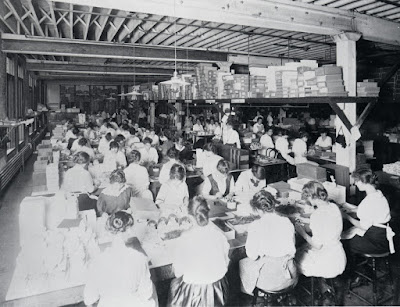Time Capsule Ghosts
Sane Halloween Observer
Just to play devil's advocate (with no reference to current listings) what follows is historical fiction that assumes minimal yet practical knowledge of the past employees of Gibson and Dennison. Note that photography sub-titles are actual, and images link to source material. And the portraits drawn here are based from this factual photography.
A Tale of Two Employees
Hallie Wiene was hired in the 1910's by the Gibson factory along with a thousand+ head-count of other employees. She performed light assembly and packed orders for millions of manufactured cards and diecuts that rolled off the assembly lines. (Departments such as printing or die-cutting with their multi-ton machinery were separate, while high-profile jobs like creative design, marketing, and sales were also elsewhere in separated offices).
Hallie loved the beautiful designs. During her employment, she squirreled away quite a collection of damaged and/or overstock items that otherwise would have entered the trash bin. She wondered what it would be like to design such products. With some of her small collection, she would cut and paste them, to use as decoration for parties at the office.
Above: 1912. South Framingham, Massachusetts. Two mothers, three children, working on tags for Dennison. Children anemic. Make $10 (more or less) a month. (Library of Congress).
Hallie's distant relative, Glenda, worked for Dennison. Hallie envied Glenda's ability to work from home, but Glenda was far removed from company life. Glenda's employer was large, at one time employing over 3,000 with offices and manufacturing located in different cities, different states. Glenda was somewhat crafty, but she was a world away from viewing the important sketchbooks and pre-die mock-ups created by the all-too distant design team. (She never learned the names of these designers, and that would have been a truly important discovery!) Glenda and children were sometimes gifted the damaged and/or excess stock, and the family sometimes altered the decorations for their parties at home.
Above: Macaroni all spread out on table being cut. Tag tying (for Dennison) going on at same table. 1912. Photograph and caption by Lewis Wickes Hine (Library of Congress archive).
Are these portraits plausible? Again, the portraits are built on factual images yet the above is historical fiction, and offered merely as counterpoint to exuberant dreams that sometimes riddle the world of collectibles. These portraits are welcome to grow and change as we gather more facts about employee life at these companies...
Earlier entries on this blog which examine assumption and reality include: Halloween Diecut Quiz (that reviews our knowledge of the diecut process), Bogie Books | Bogus Bindings (that questions assumptions of book publishing), as well as Halloween in Germany:1955 (from a series of entries questioning the production/availability history of German-made diecuts).



